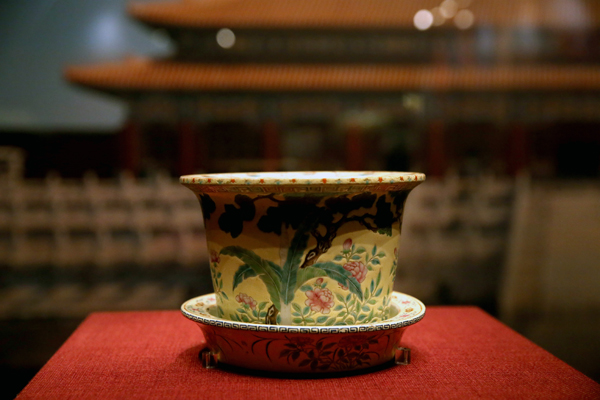
 |
|
Famille rose flowerpot and support with flower design on yellow ground. |
Another recurring motif is the gourd vine-and-butterfly, symbolizing productivity. With the line of succession already being threatened, this was a priority with the royal family. Unfortunately, historic evidence showed that the wish was not granted.
Tongzhi was the only male heir from his father, Emperor Xianfeng, and he himself died young at the tender age of 19, and left no children. The same fate befell his cousin and successor, Emperor Guangxu, Ci Xi's nephew by her twin sister.
After this first interlude, the rest of the exhibition is devoted to the Empress Dowager, fuelled mainly by her birthday celebrations, which necessitated the production of large amounts of porcelain, at a huge expense and often taxing a cash-strapped treasury.
On these occasions, Ci Xi gave way to her feminine impulses with abandon, opting for the riotous and previously rarely used deep purple and turquoise green while replacing the conventional landscape-and-character motifs with an exuberance of flowers.
Two types of flowers became the darlings of the dowager, says Zhao Congyue, porcelain expert from the Forbidden City Museum.
One was the orchid, which was the name Ci Xi was known by when she was younger, at home. The other was the lotus, sacred to Guanyin, or the Goddess of Mercy, who is often depicted as sitting on an open lotus bloom.
"As she grew older, Ci Xi started to imagine herself as the goddess," says Zhao, pointing to a black-and-white photograph hanging on the museum wall, in which the empress indulged herself in role play by getting up in the full regalia of the goddess.
"The fulfillment of this personal fantasy meant that lotus flowers had not only overtaken entire water surfaces in the royal gardens, but also found their way onto some of the finest china of the time," Zhao says.
|
|
|
| Cast in bronze | 'Xiaozhuang Pillows' of Qing Dynasty inherited |